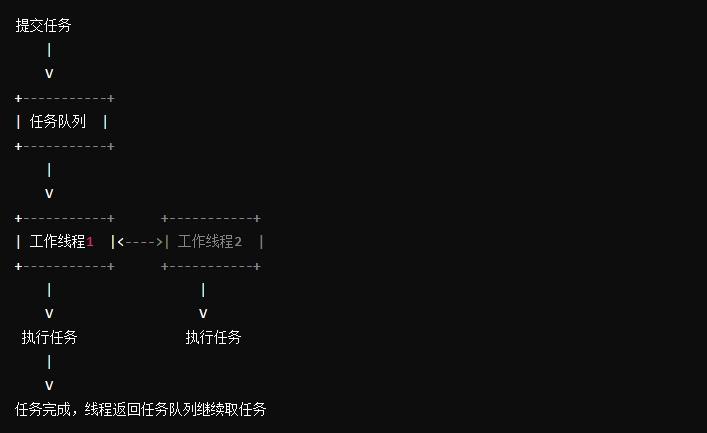在之前的Spring Boot基础教程系列中,已经通过《Spring Boot中使用@Async实现异步调用》一文介绍过如何使用 @Async注解来实现异步调用了。但是,对于这些异步执行的控制是我们保障自身应用健康的基本技能。本文我们就来学习一下,如果通过自定义线程池的方式来控制异步调用的并发。
本文中的例子我们可以在之前的例子基础上修改,也可以创建一个全新的Spring Boot项目来尝试。
定义线程池
第一步,先在Spring Boot主类中定义一个线程池,比如:
@SpringBootApplication
public class Application {
public static void main(String[] args) {
SpringApplication.run(Application.class, args);
}
@EnableAsync
@Configuration
class TaskPoolConfig {
@Bean("taskExecutor")
public Executor taskExecutor() {
ThreadPoolTaskExecutor executor = new ThreadPoolTaskExecutor();
executor.setCorePoolSize(10);
executor.setMaxPoolSize(20);
executor.setQueueCapacity(200);
executor.setKeepAliveSeconds(60);
executor.setThreadNamePrefix("taskExecutor-");
executor.setRejectedExecutionHandler(new ThreadPoolExecutor.CallerRunsPolicy());
return executor;
}
}
}
上面我们通过使用 ThreadPoolTaskExecutor创建了一个线程池,同时设置了以下这些参数:
使用线程池
在定义了线程池之后,我们如何让异步调用的执行任务使用这个线程池中的资源来运行呢?方法非常简单,我们只需要在 @Async注解中指定线程池名即可,比如:
@Slf4j
@Component
public class Task {
public static Random random = new Random();
@Async("taskExecutor")
public void doTaskOne() throws Exception {
log.info("开始做任务一");
long start = System.currentTimeMillis();
Thread.sleep(random.nextInt(10000));
long end = System.currentTimeMillis();
log.info("完成任务一,耗时:" + (end - start) + "毫秒");
}
@Async("taskExecutor")
public void doTaskTwo() throws Exception {
log.info("开始做任务二");
long start = System.currentTimeMillis();
Thread.sleep(random.nextInt(10000));
long end = System.currentTimeMillis();
log.info("完成任务二,耗时:" + (end - start) + "毫秒");
}
@Async("taskExecutor")
public void doTaskThree() throws Exception {
log.info("开始做任务三");
long start = System.currentTimeMillis();
Thread.sleep(random.nextInt(10000));
long end = System.currentTimeMillis();
log.info("完成任务三,耗时:" + (end - start) + "毫秒");
}
}
单元测试
最后,我们来写个单元测试来验证一下
@RunWith(SpringJUnit4ClassRunner.class)
@SpringBootTest
public class ApplicationTests {
@Autowired
private Task task;
@Test
public void test() throws Exception {
task.doTaskOne();
task.doTaskTwo();
task.doTaskThree();
Thread.currentThread().join();
}
}
执行上面的单元测试,我们可以在控制台中看到所有输出的线程名前都是之前我们定义的线程池前缀名开始的,说明我们使用线程池来执行异步任务的试验成功了!
2018-03-27 22:01:15.620 INFO 73703 --- [ taskExecutor-1] com.didispace.async.Task : 开始做任务一
2018-03-27 22:01:15.620 INFO 73703 --- [ taskExecutor-2] com.didispace.async.Task : 开始做任务二
2018-03-27 22:01:15.620 INFO 73703 --- [ taskExecutor-3] com.didispace.async.Task : 开始做任务三
2018-03-27 22:01:18.165 INFO 73703 --- [ taskExecutor-2] com.didispace.async.Task : 完成任务二,耗时:2545毫秒
2018-03-27 22:01:22.149 INFO 73703 --- [ taskExecutor-3] com.didispace.async.Task : 完成任务三,耗时:6529毫秒
2018-03-27 22:01:23.912 INFO 73703 --- [ taskExecutor-1] com.didispace.async.Task : 完成任务一,耗时:8292毫秒
完整示例:
读者可以根据喜好选择下面的两个仓库中查看 Chapter4-1-3项目:
如果您对这些感兴趣,欢迎star、follow、收藏、转发给予支持!
限 时 特 惠: 本站每日持续更新海量各大内部创业教程,一年会员只需98元,全站资源免费下载 点击查看详情
站 长 微 信: lzxmw777






